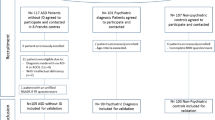Until publication of the Asperger Syndrome Diagnostic Scale (ASDS) in 2001, no standardized and nationally-normed instrument existed specifically for the purpose of diagnosing Asperger syndrome (AS) [Myles et al., 2001. Asperger Syndrome Diagnostic Scale ASDS), PRO-ED, Austin]. This study sought to augment the existing psychometric data on the ASDS through examination of its divergent, convergent, and discriminative validity. Measures of AS, autism, and social skills competence were administered to 76 children with AS, autism, intellectually gifted children, and a control group of typically developing children without AS or autism. Results supported the divergent and convergent validity of the ASDS. Discriminative validity was partially supported. The ASDS was the best discriminator between children with AS and those without AS. Diagnostic accuracy for those with AS and autism was enhanced when scores on the ASDS were combined with scores on the Gilliam Autism Rating Scale (GARS) and the Social Skills Rating System (SSRS). Findings are discussed relative to the debate over the external validity of AS and the resulting limitations on research in the area.
Similar content being viewed by others
REFERENCES
American Psychiatric Association. (1994). Diagnostic and Statistical Manual of Mental Disorders, 4th edn., American Psychiatric Association, Washington, DC.
American Psychiatric Association. (2000). Diagnostic and Statistical Manual of Mental Disorders, 4th edn., text revision, American Psychiatric Association, Washington, DC.
Attwood, T. (1998). Asperger's Syndrome: A Guide for Parents and Professionals, Jessica Kingsley, Philadelphia.
Barnhill, G., Hagiwara, T., Smith-Myles, B., and Simpson, R. (2000). Asperger syndrome: A study of the cognitive profiles of 37 children and adolescents. Focus Autism Other Dev. Disabil. 15: 146–154.
Betz, N. E. (1987). Use of discriminant analysis in counseling psychology research. J. Counsel. Psychol. 34: 393–403.
Blair, K. A. (2003). Review of the Asperger Syndrome Diagnostic Scale. In Plake, B. S., Impara, J. C., and Spies, R. A. (eds.), The Fifteenth Mental Measurements Yearbook, Buros Institute of Mental Measurements, Lincoln, NE.
Furlong, M., and Karno, M. (1995). Review of the Social Skills Rating System. In Conoley, J. C. and Impara, J. C. (eds.), The Twelfth Mental Measurements Yearbook, Buros Institute of Mental Measurements, Lincoln, NE.
Gilliam, J. E. (1995). Gilliam Autism Rating Scale, PRO-ED, Austin, TX.
Gilliam, J. E. (2001). Gilliam Asperger's Disorder Scale, PRO-ED, Austin, TX.
Gillberg, I. C., and Gillberg, C. (1989). Asperger syndrome: Some epidemiological considerations. J. Child Psychol. Psychiatry 30: 631–638.
Gresham, F. M., and Elliott, S. N. (1990). Social Skills Rating System, American Guidance Service, Circle Pines, MN.
Howlin, P. (2000). Assessment instruments for Asperger syndrome. Child Psychol. Psychiatry Rev. 5: 120–129.
Klin, A., Sparrow, S., Marans, W., Carter, A., and Volkmar, F. (2000). Assessment issues in children and adolescents with Asperger syndrome. In Klin, A., Volkmar, F., and Sparrow, S. (eds.), Asperger Syndrome, Guilford Press, New York, pp. 309–339.
Leekam, S., Libby, S., Wing, L., Gould, J., and Gillberg, C. (2000). Comparison of ICD-10 and Gillberg's criteria for Asperger syndrome. Autism 4: 11–28.
Lord, C. (1997). Diagnostic instruments in autism spectrum disorders. In Cohen, D. J. and Volkmar, F. R. (eds.), Handbook of Autism and Pervasive Developmental Disorders, Wiley, New York, pp. 460–483.
Lord, C., Risi, S., Lambrecht, L., Cook, E. H., Leventhal, B. L., DiLavore, P. C., Pickles, A., and Rutter, M. (2000). The Autism Diagnostic Observation Schedule–Generic: A standard measure of social and communication deficits associated with the spectrum of autism. J. Autism Dev. Disord. 30: 205–223.
Lord, C., Rutter, M., and Le Couteur, A. (1994). Autism Diagnostic Interview-Revised: A revised version of a diagnostic interview for caregivers of individuals with possible pervasive developmental disorders. J. Autism Dev. Disord. 24: 659–685.
Mayes, S. D., and Calhoun, S. L. (2004). Influence of IQ and age in childhood autism: Lack of support for DSM-IV Asperger's disorder. J. Dev. Physical Disabil. 16: 257–272.
Miller, J. N., and Ozonoff, S. (2000). The external validity of Asperger disorder: Lack of evidence from the domain of neuropsychology. J. Abnorm. Psychol. 109: 227– 238.
Mississippi Department of Education. (2002). Definitions and Eligibility Criteria of Disabilities.
Myles, B. S., Bock, S. J., and Simpson, R. L. (2001). Asperger Syndrome Diagnostic Scale (ASDS), PRO-ED, Austin, TX.
Ozonoff, S., and Griffith, E. (2000). Neuropsychological function and the external validity of Asperger syndrome. In Klin, A., Volkmar, F., and Sparrow, S. (eds.), Asperger Syndrome, Guilford Press, New York, pp. 72–96.
Ozonoff, S., South, M., and Miller, J. (2000). DSM-IV-defined Asperger syndrome: Cognitive, behavioral, and early history differentiation from high-functioning autism. Autism 4: 29–46.
Prior, M., Eisenmajer, R., Leekam, S., Wing, L., Gould, J., Ong, B., and Dowe, D. (1998). Are there subgroups within the autistic spectrum: A cluster analysis of a group of children with autistic spectrum disorders. J. Child Psychol. Psychiatry 39: 893–902.
Schopler, E., Reichler, R. J., and Renner, B. R. (1988). The Childhood Autism Rating Scale (CARS), Western Psychological Services, Los Angeles.
South, M., Williams, B. J., McMahon, W. M., Owley, T., Filipek, P. A., Shernoff, E., Corsello, C., Lainhart, J. E., Landa, R., and Ozonoff, S. (2002). Utility of the Gilliam Autism Rating Scale in research and clinical populations. J. Autism Dev. Disord. 32: 593– 599.
Tantam, D. (1988). Asperger's syndrome. J. Child Psychol. Psychiatry 29: 245–255.
Volkmar, F. R., Lord, C., Bailey, A., Schultz, A., and Klin, A. (2004). Autism and pervasive developmental disorders. J. Child Psychol. Psychiatry 45: 135–170.
Wing, L. (1998). The history of Asperger syndrome. In Schoplerm, E., Mesibov, G. B., and Kunce, L. J. (eds.), Asperger Syndrome or High-Functioning Autism? Plenum, New York, pp. 11–28
World Health Organization. (1993). The ICD-10 Classification of Mental and Behavioural Disorders: Diagnostic Criteria for Research, World Health Organization, Geneva.
Author information
Authors and Affiliations
Corresponding author
Rights and permissions
About this article
Cite this article
Boggs, K.M., Gross, A.M. & Gohm, C.L. Validity of the Asperger Syndrome Diagnostic Scale. J Dev Phys Disabil 18, 163–182 (2006). https://doi.org/10.1007/s10882-006-9008-6
Published:
Issue Date:
DOI: https://doi.org/10.1007/s10882-006-9008-6




